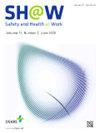Current Status of Processes and Hazardous Chemicals of Lithium-ion Battery Industries in the Republic of Korea
IF 2.9
3区 医学
Q1 PUBLIC, ENVIRONMENTAL & OCCUPATIONAL HEALTH
引用次数: 0
Abstract
Background
With global trends of carbon neutrality and ecofriendliness, the demand for lithium-ion batteries (LIBs) has been rapidly increasing. However, occupational health research within this sector is significantly lacking. Thus, this study aimed to understand the industrial value chain, processes, and current status of hazardous chemicals associated with LIBs.
Methods
Through a literature review and a survey of business sites, the LIB industry was categorized into 10 industrial groups. We visited 32 workplaces in the Republic of Korea, and conducted on-site surveys.
Results
Primary mineral raw materials used in LIBs include lithium (Li), nickel (Ni), cobalt (Co), manganese (Mn), and aluminum (Al) often in compound forms, alongside graphite, posing significant challenges in management due to their micrometer-sized particles. Furthermore, metals used in a salt form (such as LiOH or sulfate salts) can irritate the skin or respiratory system, particularly Ni and Co known to be toxic substances designated as human carcinogens by the International Agency for Research on Cancer. Acids, bases, and various solvents are also used to improve batteries' electrical properties. Dichloromethane classified as carcinogenic 2A by the International Agency for Research on Cancer is widely used in the separator industry. Carbonate-based solvents are widely used in electrolytes with potential for exposure in battery cell manufacturers and recycling industries. However, they are not classified as regulated substances, leading to inadequate management practices.
Conclusion
This study identified processes of each industry and chemical substances utilized in the LIB industry in the Republic of Korea. Based on this study, it is necessary to implement appropriate management measures tailored to industrial processes and types of harmful factors.
韩国锂离子电池工业的工艺和危险化学品现状
随着全球碳中和和生态友好的趋势,对锂离子电池(lib)的需求迅速增加。然而,这一部门的职业健康研究明显缺乏。因此,本研究旨在了解与lib相关的工业价值链、过程和危险化学品的现状。方法通过文献综述和企业选址调查,将锂离子电池产业划分为10个产业群。我们访问了韩国的32个工作场所,并进行了现场调查。结果锂离子电池中使用的主要矿物原料包括锂(Li)、镍(Ni)、钴(Co)、锰(Mn)和铝(Al),通常以化合物形式存在,此外还有石墨,由于它们的颗粒只有微米大小,因此在管理方面构成了重大挑战。此外,以盐的形式使用的金属(如LiOH或硫酸盐)会刺激皮肤或呼吸系统,特别是镍和钴,这两种已知的有毒物质被国际癌症研究机构指定为人类致癌物。酸、碱和各种溶剂也用于改善电池的电性能。二氯甲烷被国际癌症研究机构列为2A致癌物,广泛应用于分离器行业。碳酸基溶剂广泛应用于电池制造商和回收行业中具有潜在暴露的电解质。然而,它们没有被归类为受管制物质,导致管理实践不足。本研究确定了韩国LIB工业中每个行业的工艺和使用的化学物质。在此基础上,有必要针对工业流程和有害因素类型实施相应的管理措施。
本文章由计算机程序翻译,如有差异,请以英文原文为准。
求助全文
约1分钟内获得全文
求助全文
来源期刊

Safety and Health at Work
Social Sciences-Safety Research
CiteScore
6.40
自引率
5.70%
发文量
1080
审稿时长
38 days
期刊介绍:
Safety and Health at Work (SH@W) is an international, peer-reviewed, interdisciplinary journal published quarterly in English beginning in 2010. The journal is aimed at providing grounds for the exchange of ideas and data developed through research experience in the broad field of occupational health and safety. Articles may deal with scientific research to improve workers'' health and safety by eliminating occupational accidents and diseases, pursuing a better working life, and creating a safe and comfortable working environment. The journal focuses primarily on original articles across the whole scope of occupational health and safety, but also welcomes up-to-date review papers and short communications and commentaries on urgent issues and case studies on unique epidemiological survey, methods of accident investigation, and analysis. High priority will be given to articles on occupational epidemiology, medicine, hygiene, toxicology, nursing and health services, work safety, ergonomics, work organization, engineering of safety (mechanical, electrical, chemical, and construction), safety management and policy, and studies related to economic evaluation and its social policy and organizational aspects. Its abbreviated title is Saf Health Work.
 求助内容:
求助内容: 应助结果提醒方式:
应助结果提醒方式:


